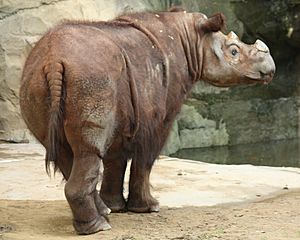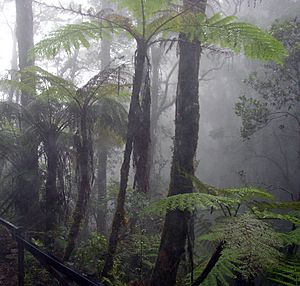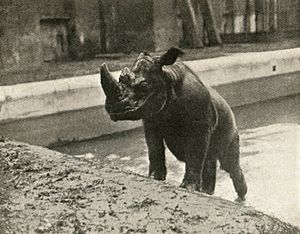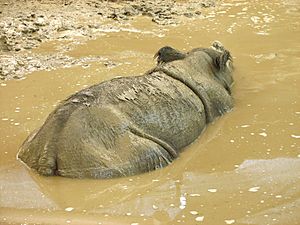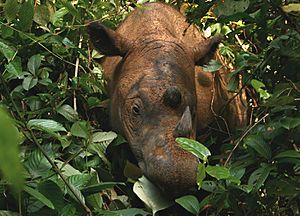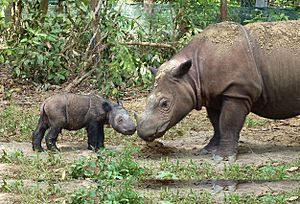Sumatran rhinoceros facts for kids
Quick facts for kids Sumatran Rhinoceros |
|
|---|---|
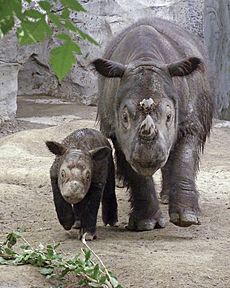 |
|
| Conservation status | |
| Scientific classification | |
| Kingdom: | |
| Class: | |
| Order: | |
| Family: | |
| Genus: |
Dicerorhinus
|
| Species: |
D. sumatrensis
|
| Binomial name | |
| Dicerorhinus sumatrensis |
|
The Sumatran Rhinoceros (Dicerorhinus sumatrensis) is a member of the family Rhinocerotidae and one of five extant rhinoceroses. It is the smallest rhinoceros, standing about 120–145 centimetres (3.9–4.8 ft) high at the shoulder, with a body length of 250 centimetres (98 in) and weight of 500–800 kilograms (1100–1760 lb).
The Sumatran rhinoceros is a small, hairy rhinoceros which survives in limited numbers in pockets of Indonesian and Malaysian rain forests. Only three institutions showcase Sumatran rhinos, the Cincinnati Zoo, the Los Angeles Zoo, and the Sumatran Rhino Sanctuary in Borneo.
Contents
Description
A mature Sumatran rhino stands about 120–145 cm (3.94–4.76 ft) high at the shoulder, has a body length of around 250 cm (8.2 ft), and weighs 500–800 kg (1,100–1,760 lb), though the largest individuals in zoos have been known to weigh as much as 2,000 kg (4,410 lb). Like the two African species, it has two horns. The larger is the nasal horn, typically only 15–25 cm (5.9–9.8 in), though the longest recorded specimen was much longer at 81 cm (32 in). The posterior horn is much smaller, usually less than 10 cm (3.9 in) long, and often little more than a knob. The larger nasal horn is also known as the anterior horn; the smaller posterior horn is known as the frontal horn. The horns are dark grey or black in color. The males have larger horns than the females, though the species is not otherwise sexually dimorphic. The Sumatran rhino lives an estimated 30–45 years in the wild, while the record time in captivity is a female D. lasiotis, which lived for 32 years and 8 months before dying in the London Zoo in 1900.
Two thick folds of skin encircle the body behind the front legs and before the hind legs. The rhino has a smaller fold of skin around its neck. The skin itself is thin, 10–16 mm (0.39–0.63 in), and in the wild, the rhino appears to have no subcutaneous fat. Hair can range from dense (the most dense hair in young calves) to scarce, and is usually a reddish brown. In the wild, this hair is hard to observe because the rhinos are often covered in mud. In captivity, however, the hair grows out and becomes much shaggier, likely because of less abrasion from walking through vegetation. The rhino has a patch of long hair around its ears and a thick clump of hair at the end of its tail. Like all rhinos, they have very poor vision. The Sumatran rhinoceros is fast and agile; it climbs mountains easily and comfortably traverses steep slopes and riverbanks.
Distribution and habitat
The Sumatran rhinoceros lives in both lowland and highland secondary rainforest, swamps, and cloud forests. It inhabits hilly areas close to water, particularly steep upper valleys with copious undergrowth. The Sumatran rhinoceros once inhabited a continuous range as far north as Burma, eastern India, and Bangladesh. Unconfirmed reports also placed it in Cambodia, Laos, and Vietnam. All known living animals occur in the island of Sumatra. Some conservationists hope Sumatran rhinos may still survive in Burma, though it is considered unlikely. Political turmoil in Burma has prevented any assessment or study of possible survivors. The last reports of stray animals from Indian limits were in 1990s.
The Sumatran rhino is widely scattered across its range, much more so than the other Asian rhinos, which has made it difficult for conservationists to protect members of the species effectively. Only four areas are known to contain Sumatran rhinoceros: Bukit Barisan Selatan National Park, Gunung Leuser National Park, and Way Kambas National Park on Sumatra; and on Indonesian Borneo west of Samarindah.
The Kerinci Seblat National Park, Sumatra's largest, was estimated to contain a population of around 500 rhinos in the 1980s, but due to poaching, this population is now considered extinct. The survival of any animals in Peninsular Malaysia is extremely unlikely.
Genetic analysis of Sumatran rhino populations has identified three distinct genetic lineages. The channel between Sumatra and Malaysia was not as significant a barrier for the rhinos as the Barisan Mountains along the length of Sumatra, for rhinos in eastern Sumatra and Peninsular Malaysia are more closely related than the rhinos on the other side of the mountains in western Sumatra. In fact, the eastern Sumatra and Malaysia rhinos show so little genetic variance, the populations were likely not separate during the Pleistocene, when sea levels were much lower and Sumatra formed part of the mainland. Both populations of Sumatra and Malaysia, however, are close enough genetically that interbreeding would not be problematic. The rhinos of Borneo are sufficiently distinct that conservation geneticists have advised against crossing their lineages with the other populations. Conservation geneticists have recently begun to study the diversity of the gene pool within these populations by identifying microsatellite loci. The results of initial testing found levels of variability within Sumatran rhino populations comparable to those in the population of the less endangered African rhinos, but the genetic diversity of Sumatran rhinos is an area of continuing study.
Although the rhino had been thought to be extinct in Kalimantan since the 1990s, in March 2013 World Wildlife Fund (WWF) announced that the team when monitoring orangutan activity found in West Kutai Regency, East Kalimantan, several fresh rhino foot trails, mud holes, traces of rhino-rubbed trees, traces of rhino horns on the walls of mud holes, and rhino bites on small branches. The team also identified that rhinos ate more than 30 species of plants. On 2 October 2013, video images made with camera traps showing the Sumatran rhino in Kutai Barat, Kalimantan, were released by the World Wildlife Fund. Experts assume the videos show two different animals, but aren't quite certain. According to the Indonesia's Minister of Forestry, Zulkifli Hasan called the video evidence "very important" and mentioned Indonesia's "target of rhino population growth by three percent per year". On 22 March 2016 it was announced by the WWF that a live Sumatran Rhino was found in Kalimantan; it was the first contact in over 40 years. The rhino, a female, is being transported to a nearby sanctuary.
Behavior
Sumatran rhinoceroses are solitary creatures except for pairing before mating and during offspring rearing. Individuals have home ranges; bulls have territories as large as 50 km2 (19 sq mi), whereas females' ranges are 10–15 km2 (3.9–5.8 sq mi). The ranges of females appear to be spaced apart; males' ranges often overlap. No evidence indicates Sumatran rhinos defend their territories through fighting. Marking their territories is done by scraping soil with their feet, bending saplings into distinctive patterns, and leaving excrement.
The Sumatran rhino is usually most active when eating, at dawn, and just after dusk. During the day, they wallow in mud baths to cool down and rest. In the rainy season, they move to higher elevations; in the cooler months, they return to lower areas in their range. When mud holes are unavailable, the rhino will deepen puddles with its feet and horns. The wallowing behaviour helps the rhino maintain its body temperature and protect its skin from ectoparasites and other insects. Captive specimens, deprived of adequate wallowing, have quickly developed broken and inflamed skins, suppurations, eye problems, inflamed nails, and hair loss, and have eventually died. One 20-month study of wallowing behavior found they will visit no more than three wallows at any given time. After two to 12 weeks using a particular wallow, the rhino will abandon it. Typically, the rhino will wallow around midday for two to three hours at a time before venturing out for food. Although in zoos the Sumatran rhino has been observed wallowing less than 45 minutes a day, the study of wild animals found 80–300 minutes (an average of 166 minutes) per day spent in wallows.
The Sumatran rhino has no known predators other than humans. Tigers and wild dogs may be capable of killing a calf, but calves stay close to their mothers, and the frequency of such killings is unknown. Although the rhino's range overlaps with elephants and tapirs, the species do not appear to compete for food or habitat. Elephants (Elephas maximus) and Sumatran rhinos are even known to share trails, and many smaller species such as deer, boars, and wild dogs will use the trails the rhinos and elephants create.
The Sumatran rhino maintains trails across its range. These trails fall into two types. Main trails will be used by generations of rhinos to travel between important areas in the rhino's range, such as between salt licks, or in corridors through inhospitable terrain that separates ranges. In feeding areas, the rhinos will make smaller trails, still covered by vegetation, to areas containing food the rhino eats. Sumatran rhino trails have been found that cross rivers deeper than 1.5 m (4.9 ft) and about 50 m (160 ft) across. The currents of these rivers are known to be strong, but the rhino is a strong swimmer. A relative absence of wallows near rivers in the range of the Sumatran rhinoceros indicates they may occasionally bathe in rivers in lieu of wallowing.
Diet
 |
 |
 |
 |
| Clockwise from top left: Mallotus, mangosteens, Ardisia, and Eugenia. | |
Most feeding occurs just before nightfall and in the morning. The Sumatran rhino is a folivore, with a diet of young saplings, leaves, twigs, and shoots. The rhinos usually consume up to 50 kg (110 lb) of food a day. Primarily by measuring dung samples, researchers have identified more than 100 food species consumed by the Sumatran rhinoceros. The largest portion of the diet is tree saplings with a trunk diameter of 1–6 cm (0.5–2.5 in). The rhinoceros typically pushes these saplings over with its body, walking over the sapling without stepping on it, to eat the leaves. Many of the plant species the rhino consumes exist in only small portions, which indicates the rhino is frequently changing its diet and feeding in different locations. Among the most common plants the rhino eats are many species from the Euphorbiaceae, Rubiaceae, and Melastomataceae families. The most common species the rhino consumes is Eugenia.
The vegetal diet of the Sumatran rhinoceros is high in fiber and only moderate in protein. Salt licks are very important to the nutrition of the rhino. These licks can be small hot springs, seepages of salty water, or mud-volcanoes. The salt licks also serve an important social purpose for the rhinos—males visit the licks to pick up the scent of females in oestrus. Some Sumatran rhinos, however, live in areas where salt licks are not readily available, or the rhinos have not been observed using the licks. These rhinos may get their necessary mineral requirements by consuming plants rich in minerals.
Communication
The Sumatran rhinoceros is the most vocal of the rhinoceros species. Observations of the species in zoos show the animal almost constantly vocalizing, and it is known to do so in the wild, as well. The rhino makes three distinct noises: eeps, whales, and whistle-blows. The eep, a short, one-second-long yelp, is the most common sound. The whale, named for its similarity to vocalizations of the humpback whale, is the most song-like vocalization and the second-most common. The whale varies in pitch and lasts from four to seven seconds. The whistle-blow is named because it consists of a two-second-long whistling noise and a burst of air in immediate succession. The whistle-blow is the loudest of the vocalizations, loud enough to make the iron bars in the zoo enclosure where the rhinos were studied vibrate. The purpose of the vocalizations is unknown, though they are theorized to convey danger, and location, as do other ungulate vocalizations. The whistle-blow could be heard at a great distance, even in the dense brush in which the Sumatran rhino lives. A vocalization of similar volume from elephants has been shown to carry 9.8 km (6.1 mi) and the whistle-blow may carry as far. The Sumatran rhinoceros will sometimes twist the saplings they do not eat. This twisting behavior is believed to be used as a form of communication, frequently indicating a junction in a trail.
Reproduction
The gestation period is around 15–16 months. The calf, which typically weighs 40–60 kg (88–132 lb), is weaned after about 15 months and stays with its mother for the first two to three years of its life. In the wild, the birth interval for this species is estimated to be four to five years; its natural offspring-rearing behavior is unstudied.
Images for kids
-
The preserved remains of the last Sumatran rhinoceros in captivity by the 1970s, a female called "Subur" which died in 1972. "Subur" ironically means "fertile" in Malay.
See also
 In Spanish: Dicerorhinus sumatrensis para niños
In Spanish: Dicerorhinus sumatrensis para niños



